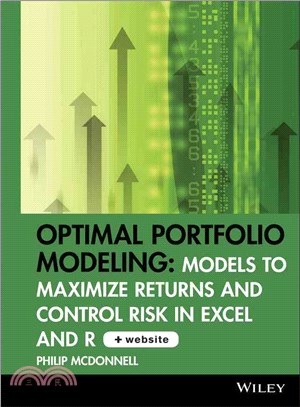| FindBook |
|
有 1 項符合
philip j. mcdonnell的圖書 |
 |
$ 2676 ~ 3230 | OPTIMAL PORTFOLIO MODELING: MODELS TO MAXIMIZE RE
作者:Philip J. Mcdonnell 出版社:JOHN WILEY & SONS,LTD 出版日期:2008-01-28 規格: / 297頁  共 2 筆 → 查價格、看圖書介紹 共 2 筆 → 查價格、看圖書介紹
|
|
|
- 圖書簡介
Optimal Portfolio Modeling is an easily accessible introduction to portfolio modeling for those who prefer an intuitive approach to this discipline. While early chapters provide engaging insights on the statistical properties of markets, this book quickly moves on to illustrate invaluable trading and risk control models based on popular programs such as Excel and the statistical modeling language R. This reliable resource presents modeling formulas that will allow you to effectively maximize the performance, minimize the drawdown, and manage the risk of your portfolio.
- 作者簡介
Philip J. Mcdonnell is a trader and software/trading methodologies developer who has created proprietary data collection and analysis tools for real-time analysis of market direction and stock selection, with an emphasis on options analysis. He has handled network operations for a venture capital incubator, The Inception Group, and developed and sold options analysis software packages. McDonnell served as a research assistant at the University of California, Berkeley, School of Business, under Victor Niederhoffer. He holds degrees in mathematics and computer science from the University of California, Berkeley.
- 目次
Foreword.
Preface.
Acknowledgments.
About the Author.
Chapter 1. Modeling Market Microstructure Randomness in Markets.
The Random Walk Model.
What You Cannot Predict Is Random To You.
Market Microstructure.
Efficient Market Hypothesis.
Arbitrage Pricing Theory.
Chapter 2. The Distribution of Price Changes.
The Normal Distribution.
The Empirical Distribution.
The Lognormal as an Approximation.
Chapter 3. Investment Objectives.
Statistician's Fair Game.
A Fair Game Is A Loser!
Criteria for a Favorable Game.
Gambler's Ruin.
Optimal Return Models.
Markets Are Rational, Psychologists Are Not.
The St. Petersburg Paradox.
Compounded Return is the Real Objective.
Defining Risk.
Minimum Risk Models.
Correlation of Assets.
Summary of Correlation Relationships.
Beta and Alpha.
The Efficient Frontier and the Market Portfolio.
The Sharpe Ratio.
Limitations of Modern Portfolio Theory.
Chapter 4. Modeling Risk Management and Stop Loss Myths.
Stop Loss Orders.
Stops: Effect on the Mean Return.
Stops: Effect on the Probability of Gain.
Stops: Probability of being stopped out.
Stops: Effect on Variance and Standard Deviation.
Effect on Skew.
Effect on the Kurtosis.
Stop Loss: Summary.
Modeling Stops.
Identifying When to Use Stops and When Not To.
Stop Profits.
Puts and Calls.
Chapter 5. Maximal Compounded Return Model.
Optimal Compound Return Models.
Relative Returns.
Average Stock Returns, but Compound Portfolio Returns.
Logarithms and the Optimal Exponential Growth Model.
Position Sizing as the Only Guaranteed Risk Control.
Controlling Risk through Optimal Position Sizing.
Maximize Compounded Portfolio Return.
Maximal Compounded Return Models.
What the Model Is and Is Not.
Modeling the Empirical Distribution.
Correlations.
The Enhanced Maximum Investment Formulas.
Expected Drawdowns May be Large.
Chapter 6. Utility Models - Preferences Toward Risk and Return.
Basis for a Utility Model.
History of Logarithms.
Optimal Compounded Utility Model.
The Sharpe Ratio.
Optimal Model for the Sharpe Ratio.
Optimization with Excel Solver.
Chapter 7. Money Management Formulas Using the Joint Multi-Asset Distribution.
The Continuous Theoretical Distributions.
Maximal Log Log Model in the presence of Correlation.
Optimal Sharpe Model with Correlation.
The Empirical Distribution.
Maximal Log Log Model in the Presence of Correlation.
Maximizing the Sharpe Ratio in the Presence of Correlation.
Chapter 8. Proper Backtesting for Portfolio Models.
Assuring Good Data.
Synchronize Data.
Use Net Changes NOT Levels.
Only Use Information from the Past.
Predictive Studies vs. Non-Predictive Studies.
Use Intraday Highs and Lows for Model Accuracy.
Adjusted Data May Be Erroneous.
Adjusting Your Own Data.
Miscellaneous Data Pitfalls.
Tabulate and Save the Detailed Results with Dates.
Overlapping Dates are Important for Correlations.
Calculate Mean, Standard Deviation, Variance and Probability of Win.
Robust Methods to Find Statistics.
Confidence Limits for Robust Statistics.
Chapter 9. The Combined Optimal Portfolio Model.
Choosing the Theoretical Distribution.
The Empirical Distribution.
Selecting Sharpe Versus a Log Log Objective Function.
Model Simulation.
Professional Money Manager versus Private Investor.
About the CD-Rom.
Contents of the CD-Rom.
Installation of the CD-Rom.
Using the Programs.
Updates to the CD-Rom.
Appendix A. Table of Values of the Normal Distribution.
Appendix B. Installing R.
Appendix C. Introduction to R.
Introduction to R Manual.
Appendix D. R Language Definition.
R Language Definition Manual.
Index.
|











